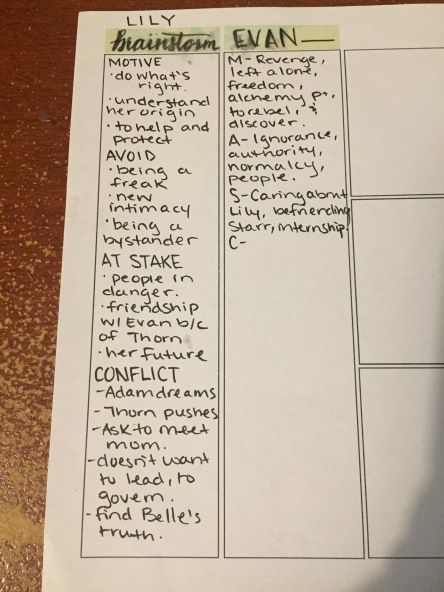Tags
brainstorming, Heart Breathings, plotting, pre-planning, project booklet, Rachael Stephen, Sarra Cannon, The Writing Process, three-act structure, writing templates
For every new project, I seem to check my system, tweak it, revise it, see if I can’t improve my writing process. Well, let’s take a fresh look at it, shall we?
Pre-Writing
I have a couple stages for my pre-writing process, and it really depends on the length of the piece as well as if the characters are completely new to me or not.
If the world is new, I like to do some character and world building first, and I’ve created a document based on Rachael Stephen’s videos on brainstorming. Download the free .pdf here if you’d like to add it to your pre-writing process.
Here’s what my first page looks like, filled out:

For a world that I’m already familiar with, I do incorporate some of those elements in to my pre-planning. Yes, I pre-plan before I plan, and maybe even pre-pre-plan. Is that a thing? Is it all just planning? If it is, don’t burst my bubble. Okay?

Here’s what my first pass at plotting looks like. I use another template. The left has two long boxes for me to note the conflicts and tension, the big themes and threads and scenes. Aka, the shit I know already. This is where I may also use a shortened version of the brainstorming template, simply listing their main motives, what they avoid, what’s at stake, and their main conflicts. It helps focus what thread is there for what reason.

In the next four columns, I split the three-act structure up the same way Sarra Cannon from Heart Breathings does—separating act two into two columns. She focuses on the main beats in each act, like so:

This is the finalized version in my project booklet. Ignore some of the fuzz, but I haven’t written the book yet, and I don’t want to reveal who done it.
One last step before I dive into my drafting process. Plotting out the chapters. Can you guess it? That’s right. I use a template. This one in fact:

Four pages, one for each column from the three-act structure. The left column is for the main themes, the scenes I need to hit, some that I may not know where they go yet. The fifteen boxes are for chapters. I try to put the points in order for each chapter.
I transfer this into a booklet with six chapters to a page because I like the clean look of it.

Drafting
When I drafted the first book in this series, THE GIRL WITH THE GLOWING HAIR, it was the first time I planned each chapter in such detail. Last time, I had to wrangle a few extra chapters in the middle for the pantsing ideas, but I stuck pretty solid to that outline. The first time I used my current templates with INFERNO, I combined a few chapters instead.
Because I’m basically a pantser. Yes, with all of this planning, I still feel like a pantser. My bare notes are enough to provide me with an idea, but I still have to hammer out a lot of details in draft. I just have fewer links to make.
Once I’ve begun the drafting phrase, I pretty much put butt in seat and write. I have a set amount I want to write a day, and I stay at it until I’ve hit my word count.
Sometimes, this is really easy. It got easier by building a habit: 250 for two months, 500 for three months, then July’s Camp NaNoWriMo pushes me to finish what I have left. Last year, my goal was 2 hours a day. It worked, and 500 a day would have been so much easier. But I enjoyed the torment, too. You know, in retrospect.
Also, I’m one of those writers who HAS to write everything in chronological order. Some people jump around, but I won’t even let myself flesh out a scene stuck in my head. I mean, I do jot notes down sometimes. I phrase or two. An image. But only on paper.
I find that I can’t move forward until I uncover the details of difficult scene. If I don’t, what I write from there is too up in the air for me. Too much could change. Although this takes me longer because I can get stuck, the revision process goes so much more smoothly.
Revision, Editing, & Publication
I’ve written about my revision and editing process before. Here, in fact. And not much has changed in this regard. Publishing changes per project. I’m still finding my way around marketing and launching books.
I do always write blog posts, create book trailers, send out newsletters, and work through Amazon, Barnes & Noble, and Kobo for distribution.
The rest is up in the air, depending on time and resources. When I sell hundreds of thousands of copies, I’ll tell you how I did it. Until then, I’ll keep playing around.
Welp, that’s it. My writing process. It took a lot of books and stories to find something that worked for me more than once. One of my favorite things about talking writing processes, is that every write does it different. So, what’s yours look like? Tell me in the comments. Write a blog post and tag me.
